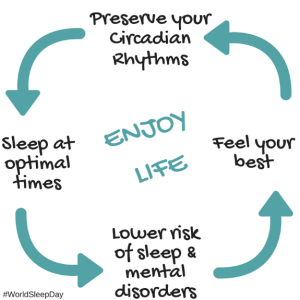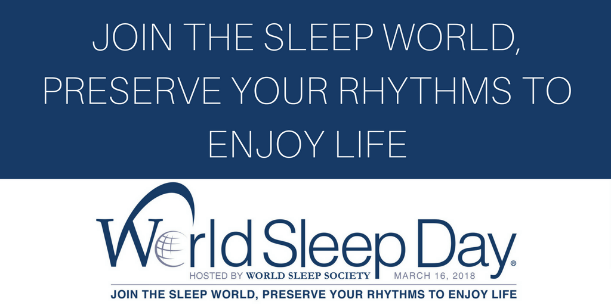Article by Josie Blake, graphics courtesy of @_worldsleep.
I love sleep, but I tend to take my peaceful rest for granted because I’m quite good at sleeping. However, this isn’t the case for everyone. For up to 45% of people across the globe, quality of life, and health is threatened by difficulties with sleeping. Of the people with frequent sleep disturbances, 46% miss events or work, or make errors at work, compared to 15% of healthy sleepers (2018 World Sleep Day Toolkit).
Friday March 16, 2018, is world sleep day. This day is aimed at raising awareness of sleep disorders, and providing education and tools for prevention and management of these disorders. Sleep disorders and irregularities present quite a load on humanity.
The World Sleep Day Toolkit (found here) points out the importance of quality sleep. Short-term consequences of poor sleep include:
- daytime sleepiness and fatigue causing reduced performance and quality of work, as well as altered hormone levels and organ function
- increased risk of accidents – people who suffer from insomnia are seven times more likely to be in an accident causing death or serious injury, compared to “good sleepers”.
- decreased attention span and memory recall – frequently interrupted sleep can affect education and learning potential.
I think we can all relate to these effects – who hasn’t made an error at work, performed poorly on the third exam in three days, or had a near miss on a late-night drive home, after a late or restless night?
The toolkit also pointed out the long term consequences of frequently interrupted and poor-quality sleep, including:
- increased risk of metabolic disorders (e.g. obesity and diabetes)
- weakened immune system
- cancer
- psychological conditions (e.g. depression and anxiety)
- reduced job prospects and loss of employment.
 These consequences occur when poor sleep disrupts your “circadian rhythm” (your 24-hour internal clock, otherwise known as your sleep/wake cycle). Most of us have experienced circadian rhythm disruptions when we travel across time zones, or work rotating shifts. Even the switch to or from daylight savings time puts us off a bit.
These consequences occur when poor sleep disrupts your “circadian rhythm” (your 24-hour internal clock, otherwise known as your sleep/wake cycle). Most of us have experienced circadian rhythm disruptions when we travel across time zones, or work rotating shifts. Even the switch to or from daylight savings time puts us off a bit.
Typically, when it gets dark outside, our eyes send a signal to our brain that tells us it’s time to become tired. (Similarly, day light signals the brain to wake up.) During travel or shift work, we are exposed to light waves that provide a “wake-up alert” at a time that our body is not expecting; our eating and sleeping behaviors are misaligned with our body’s internal timing.
During night-shift work, we need to be as safe and alert as possible to avoid accidents, so we purposely override the body’s natural inclination to sleep. In the last 10 years, LED and fluorescent lighting have become more popular – not only to reduce energy costs, but to emit more “blue-light” waves, which our bodies interpret as natural daylight. This is especially helpful for improving alertness during night shifts, when workers are more prone to be “sleepy”. (ACGIH TLVs & BEIs 2018)
Shift-workers also need good quality and quantity sleep during the day, so they can get up at night and have a successful, healthy “day”.
Here are five suggestions to help everyone achieve quality sleep:
- Set fixed times for bedtime and waking. Eventually, your body will take the hint. If you do need to nap, do not exceed 45 minutes of napping outside of regular sleeping hours.
- As much as possible, block out all noise and light, using black-out curtains, and ear plugs if necessary.
- Exercise regularly and eat healthily. Sound sleep, exercise, and good nutrition are the three “pillars” of good health.
- Avoid excessive alcohol, and avoid heavy, spicy, or sugary food during the four hours before bedtime.
- For six hours before bedtime, avoid caffeine, including coffee, tea, chocolate, and many sodas (Read the ingredients. Did you know that some root beer includes caffeine, and some doesn’t? Similarly, some clear sodas include caffeine.)
May you wake up refreshed, on this World Sleep Day!
P.S. Some workers complain about “blue-light” in office workstations. However, ACGIH (TLVs & BEIs 2018 Notice of Intent to Establish, Appendix A) reassures us that: “Worker complaints related to new installations of high-intensity, high-brightness LED lighting fixtures frequently relate to discomfort glare because of poor luminaire design or installation, not the blue-enriched spectrum of light.” If employees at your workplace are reporting headaches and eye strain due to new lighting, call us in to complete an ergo assessment for these workers. We can help to identify potential causes and solutions.
References:
World Sleep Day Toolkit, 2018. Found at: http://worldsleepday.org/toolkit on March 13, 2018.
ACGIH 2018 TLVs and BEIs Notice of Intent to Establish – Appendix A: Statement on the occupational health aspects of new lighting technologies (Appendix A – pp. 239-241).
National Sleep Foundation (2018). What is Circadian Rhythm. Found at: https://sleepfoundation.org/sleep-topics/what-circadian-rhythm on March 13, 2018.


